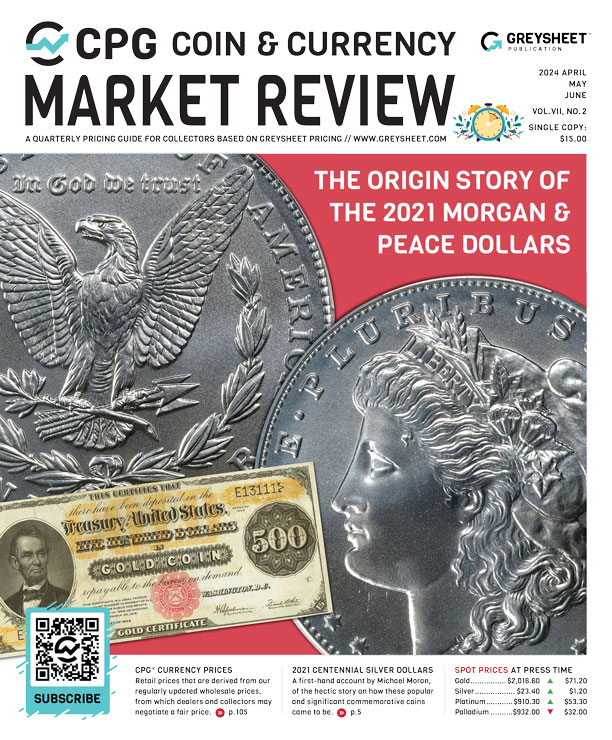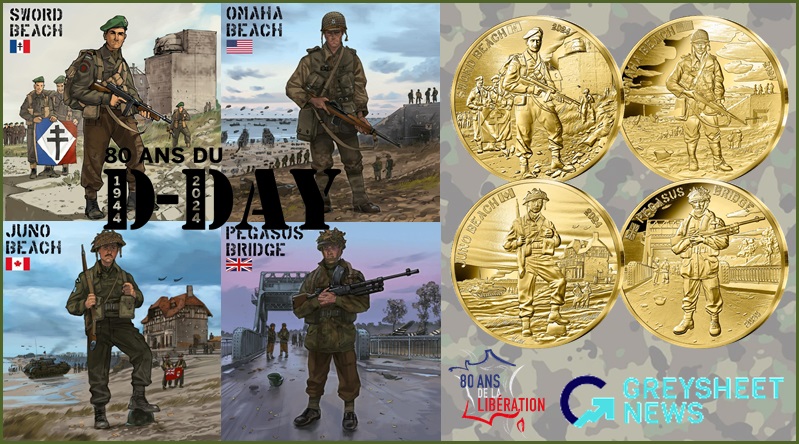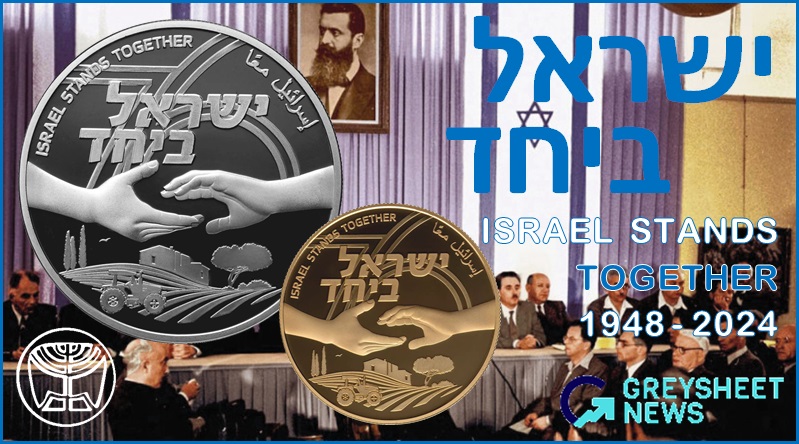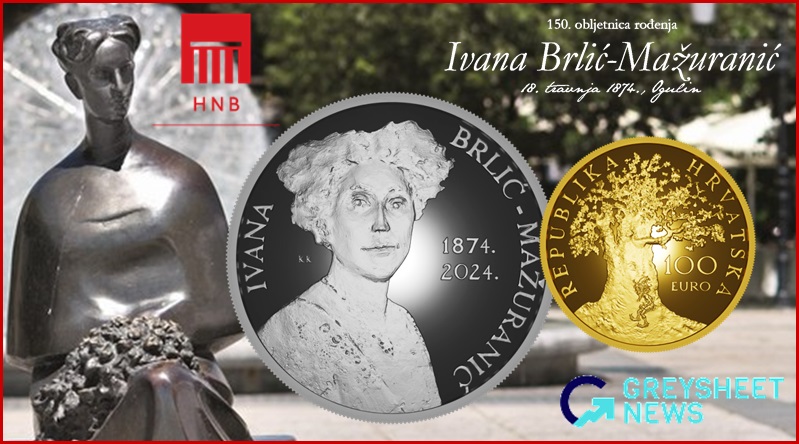France: 80th Anniversary of D-Day Launches Two-Year Commemoration and Series of Gold & Silver Proof Coins
The Monnaie de Paris have released an exceptional series of proof quality coins marking the 80th anniversary of the launch of D-day.
It was eighty years ago in June 1944 when the ambitious landing of allied forces onto the shores of France was considered the turning point in the struggle to defeat Nazi Germany and Hitler’s occupation of much of the European continent. The Allied invasion of Normandy during World War II which consisted of armed forces from Canada, the Free French Forces, the United Kingdom, and the United States was the largest seaborne invasion in history. Planning for the operation began in 1943 but in the months leading up to the invasion, the Allies conducted a substantial military deception in an effort to mislead the Germans as to the date and location of the Allied landings which had long been anticipated by Axis forces. The coded designation D merely stood for Day although to the most important persons involved, the official designation of this historic event was codenamed Operation Neptune.
General Dwight D. Eisenhower of the United States Army was appointed commander of Supreme Headquarters Allied Expeditionary Force and General Bernard Montgomery, affectionately known as “Monty” of the British Army was named as commander of the 21st Army Group, which comprised all of the land forces involved in the invasion. 12,000 planes of the Allied Air Forces cleared the Luftwaffe from the skies and photographed enemy defences whilst the Allied Naval Forces patrolled the English Channel, patrolled the beaches and their defences. On D-Day itself, the 6th June 1944 – and despite unfavourable weather conditions, more than 1,000 transports dropped paratroopers to secure the beaches. Amphibious craft landed over 130,000 troops on five beaches along the Normandy coast. British and Canadian forces landed on Gold, Juno and Sword Beaches whilst American troops landed on Utah and Omaha Beaches. In the weeks following the invasion, Polish forces also participated, as well as contingents from Belgium, Czechoslovakia, Greece, and the Netherlands. Out of 156,000 fighting men, the allied armies suffered nearly 12,000 casualties with 4,414 confirmed fatalities. The five bridgeheads or landing points were not connected until the 12th June, by which time the Allies held a front of around 60 miles (97 km) long and 15 miles (24 km) deep. Caen, a major objective, was still in German hands at the end of D-Day and would not be completely captured until the 21st July. From this new front, the allied armies continued their push into Western Europe with a Soviet offensive on the Eastern front from Belorussia occurring on the 22nd June and resulting in the almost complete destruction of the German Army Group Centre.
At midnight on June 6 and in the days that followed, around 150,000 men and 20,000 vehicles, representing a total of 15 different nations, landed on the beaches of Normandy to liberate the territory. It took the Allies more than three months to reach Paris and liberate the capital, putting an end to 4 years of German occupation. Within less than a year from the D-Day launch, the Third Reich of Hitler’s Nazi regime capitulated entirely and an unconditional surrender was accepted by the Allied command on the 7th May 1945.

Design - Because Normandy would not have been liberated without the Allied nations, the Monnaie de Paris has decided to pay tribute to this historic event through a series of stories. The collector coins in this collection are dedicated to 4 soldiers from the 4 major Allied nations, each of whom landed in Normandy on the June 6th 1944. These 4 fictional heroes exemplify the stories of soldiers who actually fought during the Normandy landings. Each detailed depiction on the obverse side is the work of Joaquin Jimenez, General Engraver of Monnaie de Paris.
Omaha Beach - James is an American officer in the 1st Infantry Division and landed on Omaha Beach, nicknamed "Bloody Omaha". Here, he poses in front of the beach at the end of the day. In the background are the bunkers, as well as the many landing crafts and ships out to sea to support the beachhead.
Juno Beach – Fred is a lieutenant with the Royal Winnipeg Rifles, nicknamed the "Little Black Devils", and a member of the 3rd Canadian Infantry Division. He landed on Sword Beach at Graye, near Courseulles. He poses in front of the beach, where we can see a Churchill AVRE tank, two soldiers from his unit holding the
Canadian flag as it was in 1944, and a traditional house from the Côte de Nacre landscape.
Sword Beach – Léon is a Second-Maitre (Petty Officer) of the Commando Kieffer, and was one of the 177 Frenchmen who took part in the Normandy landings on the beach known as "Sword Beach", alongside British forces as part of Commando N°4. Here he poses in front of one of the Ouistreham bunkers, with his comrades in the background holding the flag of the Free French Naval Forces.
Pegasus Bridge – Richard is a British Glider with the Air-landing Brigade, and was part of the 6th Airborne (British and Canadian). He landed on the night of June 6, 1944, in a glider to the east of Sword Beach. Here he poses in front of Pegasus Bridge after the successful completion of Operation Deadstick. The glider in which he landed is in the background under the trees.
The reverse of all coins in this series features flag representations of all the Allied countries that officially took part in the Normandy landings, surrounded by the face value 50 EURO (gold) 10 EURO (silver) or ¼ EURO (alum-Br) and the initials RF for REPUBLIQUE FRANCAISE. Clockwise the flags are those of the Free French, the Netherlands, New Zealand, Poland, Australia, USA, Norway, UK, Czechoslovakia, Canada and Belgium. The commemorative text placed above the primary design along the upper rim reads Du D-Day au VE-Day 80eme Anniversaire. To the lower left and right are the commemorative years 1944 and 1945 along with a collection of five five-pointed stars in tribute to the Liberty Road, the milestones marking the route taken by the 3rd American Army to liberate France, and all the way to Luxembourg.
| Denomination | Metal | Weight | Diameter | Quality | Mintage Limit |
| ¼ Euro X 4 | Alum-Br | 15.8 g. | 34 mm. | BU | 10,000 each |
| 10 Euro X 4 | .999 Silver | 22 g. | 37 mm. | Proof | 1,944 Each |
| 50 Euro X 4 | .999 Gold | 7.78 g. | 22 mm. | Proof | 500 Each |
Each base metal BU coin is enclosed in a card format presentation which includes the printed artwork featured on the coin. The gold and silver proof coins are encapsulated and presented in a custom case accompanied with a numbered certificate of authenticity. For additional information, please visit the online webshop of the Monnaie de Paris.

Download the Greysheet app for access to pricing, news, events and your subscriptions.
Subscribe Now.

Subscribe to CPG® Coin & Currency Market Review for the industry's most respected pricing and to read more articles just like this.
Author: Michael Alexander











